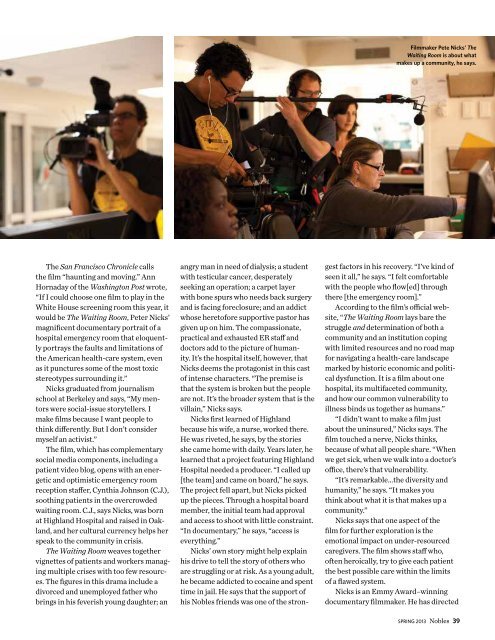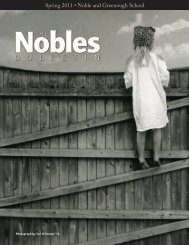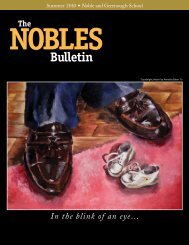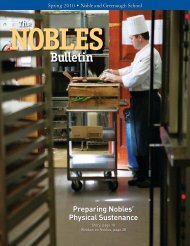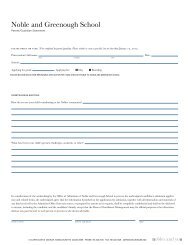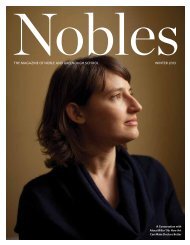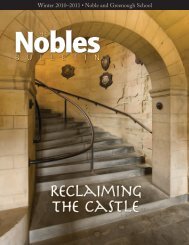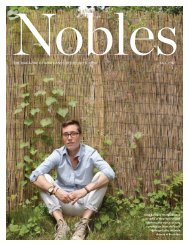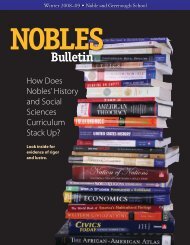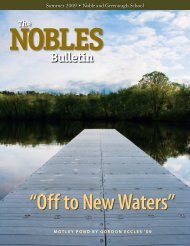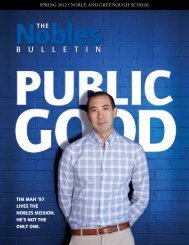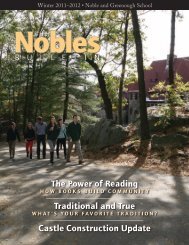download the PDF version - Noble and Greenough School
download the PDF version - Noble and Greenough School
download the PDF version - Noble and Greenough School
Create successful ePaper yourself
Turn your PDF publications into a flip-book with our unique Google optimized e-Paper software.
Filmmaker Pete Nicks’ TheWaiting Room is about whatmakes up a community, he says.The San Francisco Chronicle calls<strong>the</strong> film “haunting <strong>and</strong> moving.” AnnHornaday of <strong>the</strong> Washington Post wrote,“If I could choose one film to play in <strong>the</strong>White House screening room this year, itwould be The Waiting Room, Peter Nicks’magnificent documentary portrait of ahospital emergency room that eloquentlyportrays <strong>the</strong> faults <strong>and</strong> limitations of<strong>the</strong> American health-care system, evenas it punctures some of <strong>the</strong> most toxicstereotypes surrounding it.”Nicks graduated from journalismschool at Berkeley <strong>and</strong> says, “My mentorswere social-issue storytellers. Imake films because I want people tothink differently. But I don’t considermyself an activist.”The film, which has complementarysocial media components, including apatient video blog, opens with an energetic<strong>and</strong> optimistic emergency roomreception staffer, Cynthia Johnson (C.J.),soothing patients in <strong>the</strong> overcrowdedwaiting room. C.J., says Nicks, was bornat Highl<strong>and</strong> Hospital <strong>and</strong> raised in Oakl<strong>and</strong>,<strong>and</strong> her cultural currency helps herspeak to <strong>the</strong> community in crisis.The Waiting Room weaves toge<strong>the</strong>rvignettes of patients <strong>and</strong> workers managingmultiple crises with too few resources.The figures in this drama include adivorced <strong>and</strong> unemployed fa<strong>the</strong>r whobrings in his feverish young daughter; anangry man in need of dialysis; a studentwith testicular cancer, desperatelyseeking an operation; a carpet layerwith bone spurs who needs back surgery<strong>and</strong> is facing foreclosure; <strong>and</strong> an addictwhose heretofore supportive pastor hasgiven up on him. The compassionate,practical <strong>and</strong> exhausted ER staff <strong>and</strong>doctors add to <strong>the</strong> picture of humanity.It’s <strong>the</strong> hospital itself, however, thatNicks deems <strong>the</strong> protagonist in this castof intense characters. “The premise isthat <strong>the</strong> system is broken but <strong>the</strong> peopleare not. It’s <strong>the</strong> broader system that is <strong>the</strong>villain,” Nicks says.Nicks first learned of Highl<strong>and</strong>because his wife, a nurse, worked <strong>the</strong>re.He was riveted, he says, by <strong>the</strong> storiesshe came home with daily. Years later, helearned that a project featuring Highl<strong>and</strong>Hospital needed a producer. “I called up[<strong>the</strong> team] <strong>and</strong> came on board,” he says.The project fell apart, but Nicks pickedup <strong>the</strong> pieces. Through a hospital boardmember, <strong>the</strong> initial team had approval<strong>and</strong> access to shoot with little constraint.“In documentary,” he says, “access iseverything.”Nicks’ own story might help explainhis drive to tell <strong>the</strong> story of o<strong>the</strong>rs whoare struggling or at risk. As a young adult,he became addicted to cocaine <strong>and</strong> spenttime in jail. He says that <strong>the</strong> support ofhis <strong>Noble</strong>s friends was one of <strong>the</strong> strongestfactors in his recovery. “I’ve kind ofseen it all,” he says. “I felt comfortablewith <strong>the</strong> people who flow[ed] through<strong>the</strong>re [<strong>the</strong> emergency room].”According to <strong>the</strong> film’s official website,“The Waiting Room lays bare <strong>the</strong>struggle <strong>and</strong> determination of both acommunity <strong>and</strong> an institution copingwith limited resources <strong>and</strong> no road mapfor navigating a health-care l<strong>and</strong>scapemarked by historic economic <strong>and</strong> politicaldysfunction. It is a film about onehospital, its multifaceted community,<strong>and</strong> how our common vulnerability toillness binds us toge<strong>the</strong>r as humans.”“I didn’t want to make a film justabout <strong>the</strong> uninsured,” Nicks says. Thefilm touched a nerve, Nicks thinks,because of what all people share. “Whenwe get sick, when we walk into a doctor’soffice, <strong>the</strong>re’s that vulnerability.“It’s remarkable…<strong>the</strong> diversity <strong>and</strong>humanity,” he says. “It makes youthink about what it is that makes up acommunity.”Nicks says that one aspect of <strong>the</strong>film for fur<strong>the</strong>r exploration is <strong>the</strong>emotional impact on under-resourcedcaregivers. The film shows staff who,often heroically, try to give each patient<strong>the</strong> best possible care within <strong>the</strong> limitsof a flawed system.Nicks is an Emmy Award–winningdocumentary filmmaker. He has directedspring 2013 <strong>Noble</strong>s 39


